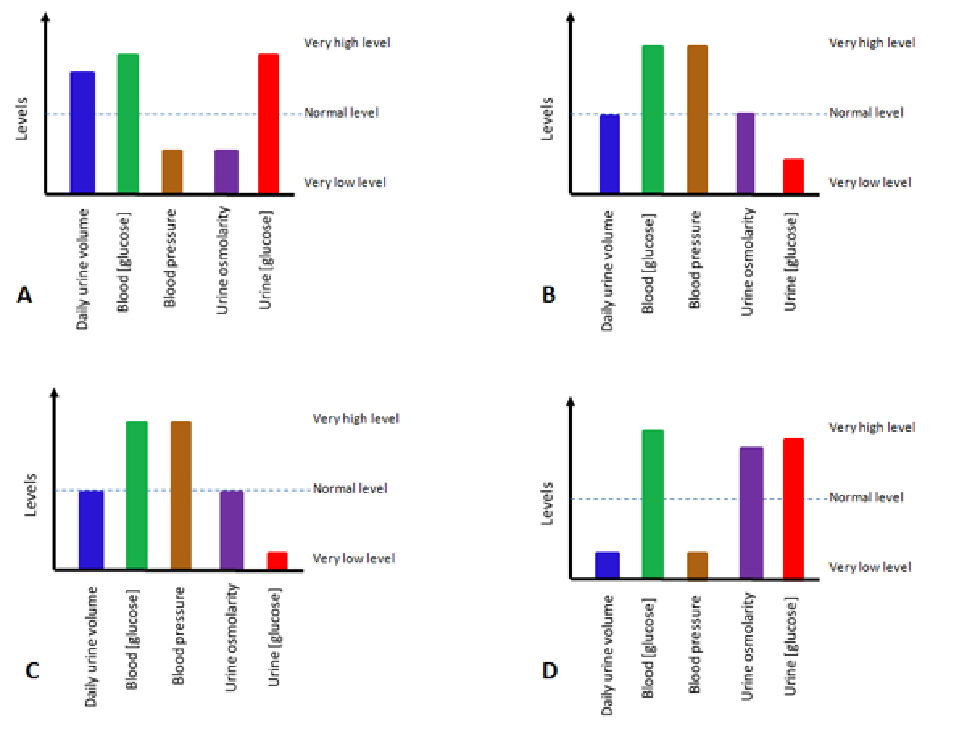Roger, who has Type I diabetes mellitus, forgot to take along his insulin on a fishing trip to a remote part of Alaska. It takes him three days to make it out of the wilderness to a hospital. What would be the most likely match to Roger’s blood and urine profile once he reaches the hospital?

A. A
B. B
C. C
D. D
Clarify Question
What is the key concept addressed by the question?
What type of thinking is required?
Gather Content
What do you already know about diabetes mellitus? What other information is related to the question?
Choose Answer
Given what you now know, what information is most likely to produce the correct answer?
Reflect on Process
Did your problem-solving process lead you to the correct answer? If not, where did the process break down or lead you astray? How can you revise your approach to produce a more desirable result?
A. A
Clarify Question
What is the key concept addressed by the question?
· This question is asking about the body chemistry of a person with untreated diabetes mellitus Type I.
What type of thinking is required?
· Analyze level:
o This is an analyze question because you have to break blood chemistry and urine chemistry into their component pieces to understand how they function in a patient with untreated diabetes mellitus Type I.
Gather Content
What do you already know about diabetes mellitus? What other information is related to the question?
· Diabetes mellitus Type I is juvenile-onset diabetes, although it may be diagnosed at any age.
· This condition can result in high blood sugar levels, as insufficient insulin is available to cells.
· Insulin stimulates cells to take up blood sugar, thereby keeping blood sugar levels in a homeostatic range.
· When blood sugar levels are high, excess blood sugar can be excreted with the urine.
· As a solute, the presence of sugar in the urine increases the volume of urine, as more water moves into the urine through osmosis.
Choose Answer
Given what you now know, what information is most likely to produce the correct answer?
· All of the patients in this question have abnormally high blood glucose levels, so this cannot be used as a deciding factor.
· Only one patient, shown in choice A, has abnormally high urine volume. This is consistent with someone who has untreated diabetes mellitus.
Reflect on Process
Did your problem-solving process lead you to the correct answer? If not, where did the process break down or lead you astray? How can you revise your approach to produce a more desirable result?
· Analyze level:
o Answering this question correctly depended not only on distinguishing between urine composition and blood composition, but on your ability to break down, or analyze, the effects of diabetes mellitus Type I. If you got an incorrect answer, did you remember that components of individuals with this condition have insufficient insulin, or that this increases blood sugar levels as well as urine sugar levels and urine volume? Did you have trouble breaking down the effects of diabetes mellitus to determine the correct answer?
You might also like to view...
What are the bird-like and reptile-like features of Archaeopteryx? What will be an ideal response?
Most developed countries have passed through a demographic transition and currently have low population growth rates
Indicate whether the statement is true or false
Local signs of infection include.
A) fever and leukocytosis. B) headache and anorexia. C) pain, erythema, and swelling. D) nausea, weight loss, and fatigue.
In temperate zones, pinworms are the most common helminth infection.
Answer the following statement true (T) or false (F)